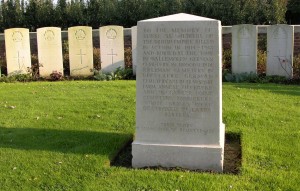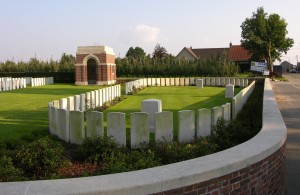
One of three Duhallow Blocks at Perth Cemetery (China Wall), West-Vlaanderen, Belgium.
(P. Ferguson image, September 2005)
Duhallow Blocks
Duhallow ADS (Advanced Dressing Station) Cemetery, Belgium lent itself to the naming of a special memorial feature produced by the Imperial War Graves Commission (IWGC) known as the Duhallow Block. These special memorials were first placed at the Duhallow cemetery, near Ypres.

Duhallow Blocks at Perth Cemetery (China Wall), West-Vlaanderen, Belgium.
(P. Ferguson image, September 2005)
The blocks, as well as a related style headstone, are the memorial record when the exact location of a burial, within a particular cemetery, is not known due to a record of the burial not being kept or the grave was destroyed through the course of the war. Duhallow Blocks are also known as Kipling Memorials as the inscription upon them, THEIR GLORY SHALL NOT BE BLOTTED OUT [Ecclesiasticus] was chosen by IWGC literary adviser, Rudyard Kipling. In some instances a headstone rather than a block records the words from Ecclesiasticus. These headstones record the superscription Known To Be Buried In This Cemetery.
At some war graves cemetery sites one will find headstones grouped around a Duhallow Block. These headstones are without the superscription Known To Be Buried In This Cemetery. This landscaping is done when there are more than six graves of this type at a cemetery.
Tags: Duhallow ADS Cemetery, Duhallow Block, Ecclesiasticus, Imperial War Graves Commission, Kipling Memorial, Perth Cemetery (China Wall), Rudyard Kipling, Special Memorials, Their Glory Shall Not Be Blotted Out
This entry was posted by pferguson
on Wednesday, November 6th, 2019 at 11:19 pm and is filed under Remember Them Well.
You can follow any responses to this entry through the RSS 2.0 feed.
You can leave a response, or trackback from your own site.
About The Author

Paul has worked with the Paradigm Motion Picture Company since 2009 as producer, historian and research specialist. Paul first met Casey and Ian WIlliams of Paradigm in April 2007 at Ieper (Ypres), Belgium when ceremonies were being held for the re-dedication of the Vimy Memorial, France.
Paul's sensitivity to film was developed at an early age seeing his first films at RCAF Zweibrucken, Germany and Sardinia. Paul returned to Canada in 1967 and was captivated by David Lean's "Lawrence of Arabia" and "Bridge on the River Kwai". Over time Paul became increasingly interested in storytelling, content development, character, direction, cinematography, narration and soundtracks.
At the University of Victoria, Paul studied and compared Japanese and Australian film and became interested in Australian film maker Peter Weir and his film "Gallipoli" (1981). Paul was inspired when he learned Weir visited the beaches, ridges and ravines of the peninsula. "Gallipoli", the film, led Paul on many journeys to sites of conflict in England, France, Belgium, Holland, Germany, Malta, Hawaii, Gallipoli, North Macedonia and Salonika.
When Paul first watched documentary filmmaker Ken Burns, "The Civil War", Paul understood how his own experience and insight could be effective and perhaps influential in film-making. Combining his knowledge of Museums and Archives, exhibitions and idea strategies with his film interests was a natural progression.
Paul thinks like a film-maker. His passion for history and storytelling brings to Paradigm an eye (and ear) to the keen and sensitive interests of; content development, the understanding of successful and relational use of collections, imagery and voice. Like Paul's favorite actor, Peter O'Toole, Paul believes in the adage “To deepen not broaden.”
While on this path Paul always remembers his grandmother whose father did not return from the Great War and how his loss shaped her life and how her experience continues to guide him.



Comments